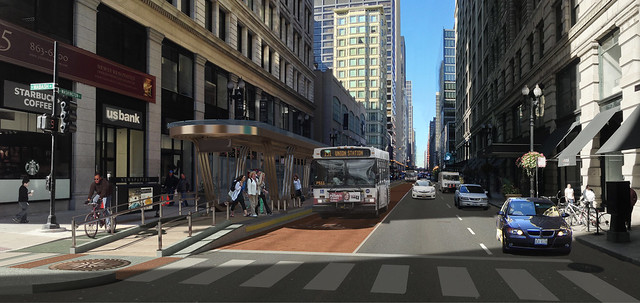I recently sat down with Chicago Department of Transportation Commissioner Rebekah Scheinfeld to discuss the city’s efforts to create safer, more efficient conditions for walking, transit and biking. We’ll be publishing the interview in a few installments, starting with this conversation about plans for bus rapid transit in the Loop.
John Greenfield: What’s going on with the schedule for the Loop BRT? I’ve heard there has been a little pushback from business owners. Some of them weren’t excited about the idea of having large bus stations in front of their storefronts, even though the design is transparent. So, when are you thinking that’s going to get rolled out and how many stations does it look like we’re going to get?
Rebekah Scheinfeld: We’re still planning to start construction this year. We have to finish the design process, and then it will go through the procurement process for the construction contractor, and there will be a full season of construction. So the expectation is that it will be operational by the end of 2015. And that also includes the Union Station Transit Center.
The design for the Washington and Madison corridors calls for eight stations at major connection points. We’re still working through the design. Obviously, it’s complex because it’s a major investment in the heart of the Loop, and it requires a lot of coordination with the different users: building owners, business owners, and other constituencies along both corridors.
So, we’re being thoughtful about the design and we’re working through concerns that are being raised through the outreach process we started last year, to reach out to stakeholders in the corridor, to make sure they’re aware of the project, and to talk through any impact concerns that they have about how the street is going to be reconfigured. That’s an ongoing process.
JG: What are some of the concerns the business owners have?
RS: One, it’s about understanding what the project entails, in terms of how the street would be designed and the way that there will be space allocated to bikes and pedestrians and transit and regular, general through traffic. We’re explaining that, just to get beyond any pre-conceived notions that people might have, like worries that the streets are only going to be only for buses, or something like that.
We’re explaining that this is going to be a corridor for all users, as well as explaining that there are going to be impacts in terms of where people can load or unload, for example. Obviously, businesses want to make sure that they can accommodate deliveries, for example. And there’ll be some minor offsets to parking. So a lot of it is about education, and each block is not cookie-cutter. On every block there are different kinds of buildings and different kinds of uses, so we take that very seriously.
JG: You have heard some concerns from people worried that their storefronts are going to be obscured, right?
RB: That was an early question that was raised, so we’re doing a lot to make sure that there is transparency in the design, but also that any information panels in the shelters would be perpendicular to the sidewalk, so that it maximizes the view and the sightlines.
The thing that we keep hearing over and over, and it’s important to reiterate, is how important this investment is in terms of moving people more efficiently across the Loop. You know, people are always concerned at some level about any change. And so it takes education and good communication to make a successful project, especially in a complex space.
Everyone will agree that for decades, it’s been a real challenge trying to move people efficiently across these corridors, and that there’s a lot of congestion. I think you’ve seen the statistics, in terms of how many people are riding transit across the Loop. [The BRT corridor will serve 11 bus routes that currently transport a total of 93,764 daily.] We know that often those buses are moving slower than an able-bodied person can on the sidewalk. That’s just upside-down.
You have buildings like the Prudential Center and Aon where they’re paying for private shuttles because they want to be able to get people from the west side of the Loop and commuter rail stations over to their buildings more expeditiously. You have had a series of failed attempts to address the problem, like the Central Area Circulator proposal. This is not a new issue.
We’re excited because this is really going to attack that issue of moving people more efficiently across the Loop, giving priority to transit, recognizing the great number of people that are on those buses and the importance of moving those buses efficiently and effectively so that people can get to their jobs on time, so they can get home on time, and so they can get to school on time.







